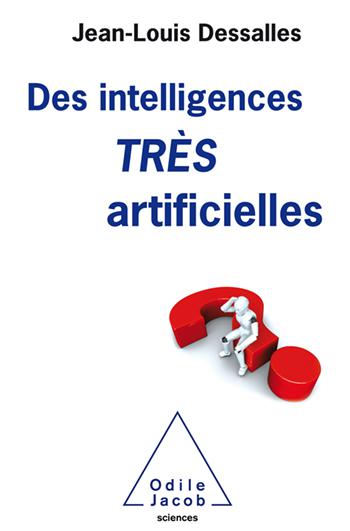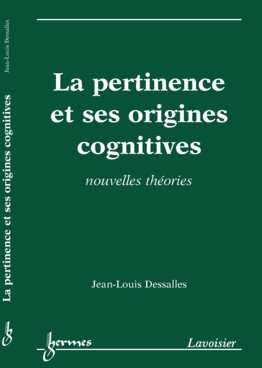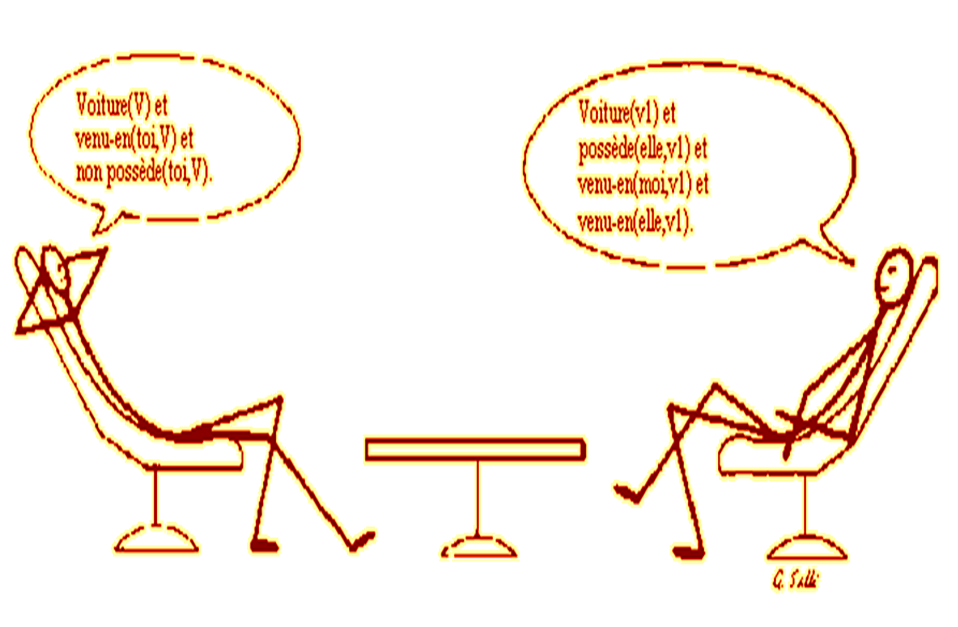Jean-louis Dessalles - Publications [See all papers] - [Selected Papers] - [Talks]
See also Books:







 Topics
Topics
 Social signals
Social signals
Evolutionary origins of language
Evolution and information
Simplicity Theory
Cognitive modelling of interest
Cognitive modelling of relevance
Cognitive modelling of meaning
Cognitive modelling of emotional intensity
Cognitive modelling of concept learning
Emergence as complexity drop
Qualia cannot be epiphenomenal
→ [ See all papers ] → [ Selected papers ]
Selected topic: Cognitive modelling of relevance
| During spontaneous conversation, individuals engage in discussions.
This behaviour is made possible by their ability to detect logical inconsistencies
and to perceive contradictions between facts and desires. I am proposing a minimal procedure named
CAN: Conflict-Abduction-Negation that aims at capturing the human argumentative competence. |
My 24 papers about ARGUMENTATION (but see my other papers)
-
Houzé, E., Dessalles, J.-L., Diaconescu, A., Menga, D. & Schumann, M. (2022). A decentralized explanatory system for intelligent cyber-physical systems. In K. Arai (Ed.), Intelligent Systems and Applications. IntelliSys 2021, 719-738. Lecture Notes in Networks and Systems, vol 294. Springer.
Keywords: ARGUMENTATION
The Internet of Things (IoT) has been a prominent application for Intelligent Systems in recent years. While the increasing demand for explanations led to many advances in Explainable Artificial Intelligence (XAI), most solutions focus on systems where a single agent takes all decisions to be explained. However within the IoT context, Cyber-Physical Systems (CPS) are decentralized, with multiple agents coordinating their decisions to control the overall CPS. By contrast users expect coherent system-wide explanations, as if they were generated by a single agent. We propose a decentralized Explanation System generating such explanations while preserving the advantages of decentralized control: separation of concerns, heterogeneity, flexibility, ...Our architecture relies on: i) decentralized XAI Component specialists for providing partial explanations based on local knowledge; ii) a central generic Spotlight composing local explanations into a global explanation. We illustrate and qualitatively evaluate our approach via a proof-of-concept implementation for a smart home system.
→ Download PDF Share: -
Houzé, E., Diaconescu, A. & Dessalles, J.-L. (2021). Using Decentralised Conflict-Abduction-Negation in Policy-making. 1st Workshop on Agent-based Modelling and Policy-Making Vilnius (hybrid), Lithuania: .
Keywords: ARGUMENTATION
→ Download PDF Share: -
Dessalles, J.-L. (2016). A Cognitive Approach to Relevant Argument Generation. In M. Baldoni, C. Baroglio, F. Bex, T. D. Bui, F. Grasso & et al. (Eds.), Principles and Practice of Multi-Agent Systems, LNAI 9935, 3-15. Springer.
Keywords: ARGUMENTATION
Acceptable arguments must be logically relevant. This paper describes an attempt to retro-engineer the human argumentative competence. The aim is to produce a minimal cognitive procedure that generates logically relevant arguments at the right time. Such a procedure is proposed as a proof of principle. It relies on a very small number of operations that are systematically performed: logical conflict detection, abduction and negation. Its eventual validation however depends on the quality of the available domain knowledge.
→ Download PDF Share: -
Dessalles, J.-L. (2016). Narration and reasoning, from structure to biological function. In A. Rocci & L. de Saussure (Eds.), Handbook of communication science, 205-223. Berlin: De Gruyter Mouton.
Keywords: ARGUMENTATION NARRATIVE
Human conversation has a particular structure that bears no resemblance with any other known communication system. People’s spontaneous talking comes in two forms: narratives and collective argumentative reasoning. This characteristic conversational structure cannot be fortuitous. Conversation is a costly behaviour, if only by the time and energy it demands. Surprisingly, there have been few attempts to relate conversational structure to any biological function it may have. This chapter illustrates conversational structure with examples and explores the issue of its biological purpose.
→ Download PDF Share: -
Dessalles, J.-L. (2011). Sharing cognitive dissonance as a way to reach social harmony. Social Science Information, 50 (1), 116-127.
Keywords: NARRATIVE ARGUMENTATION
Commonsense wisdom dictates that mutual understanding grows with cognitive harmony. Communication seems impossible between people who do not share values, beliefs and concerns. If brought to the extreme, this statement however neglects the fact that the formation of social bonds crucially depends on the expression of cognitive dissonance.
→ Download PDF Share: -
Dessalles, J.-L. (2011). Reasoning as a lie detection device (Commentary on Mercier and Sperber:’Why do humans reason? Arguments for an argumentative theory'). Behavioral and Brain Sciences, 34 (2), 76-77.
Keywords: ARGUMENTATION EVOL.&LANG.
The biological function of human reasoning abilities cannot be to improve shared knowledge. This is at best a side effect. A more plausible function of argumentation, and thus of reasoning, is to advertise one’s ability to detect lies and errors. Such selfish behavior iscloser to what we should expect from a naturally selected competence.
→ Download PDF Share: -
Dessalles, J.-L. (2010). In praise of resemblance: Human communicational universals as basis for mutual acceptance. Generalized Science of Humanity Series, 5, 65-73.
Keywords: ARGUMENTATION
In the human species, individuals establish social bonds mainly based on communication. Among the qualities that are used by individuals to include other individuals in their social network, the ability to demonstrate one’s relevance in the eye of others proves crucial. In this respect, relevance can be more important than sharing a common culture or a common language. Fortunately, the principles that govern relevance in communication seem to be universal and deeply rooted in our biology, enabling any two individuals in our species to become friends, regardless of their differences.
→ Download PDF Share: -
Dessalles, J.-L. (2008). A computational model of argumentation in everyday conversation: a problem-centred approach. In P. Besnard, S. Doutre & A. Hunter (Eds.), Computational Models of Argument - Proceedings of COMMA 2008, 128-133. Amsterdam: IOS Press.
Keywords: ARGUMENTATION
Human beings share a common competence for generating relevant arguments. We hypothesize the existence of a cognitive procedure that enables them to determine the content of their arguments. We consider that this procedure must be simple to have cognitive plausibility. This paper is an attempt to determine central aspects of this cognitive procedure. The originality of the present approach is to analyse spontaneous argument generation as a process in which arguments either signal problems or aim at solving previously acknowledged problems.
→ Download PDF Share: -
Dessalles, J.-L. (2001). La récursivité dans le dialogue argumentatif. In B. Chaib-Draa & P. Enjalbert (Eds.), Actes des journées francophones ‘Modèles formels de l’interaction’ (MFI-01), 49-59. Toulouse: Université de Toulouse.
Keywords: ARGUMENTATION
Les interventions, au cours d’un dialogue argumentatif, sont logiquement reliées les unes aux autres. De ce fait, l’agencement des répliques prend une forme arborescente, qui apparaît comme une structure fractale : la structure locale d’une partie du dialogue ressemble à la structure qui l’englobe. Nous montrons ensuite comment une telle structure peut être vue comme le résultat de l’application récursive d’une procédure de génération d’arguments. Nous envisageons enfin la faisabilité d’une capacité artificielle de dialogue construite autour d’une telle procédure récursive.
→ Télécharger une version PDF de cet article Share: -
Dessalles, J.-L. & Ghadakpour, L. (1999). L’activité scientifique en tant que comportement naturel ancré sur le conflit cognitif. Conflits des interprétations et interprétation des conflits - Actes des journées de Rochebrune, 87-98. Paris: ENST.
Keywords: ARGUMENTATION
→ Télécharger une version PDF de cet article Share: -
Dessalles, J.-L. (1998). Casual conversation as logical constraint satisfaction. In J. Allwood (Ed.), Proceedings of the European Summer School in Logic, Language and Information (ESSLLI-98), Workshop on Pragmatics and Logic, 27-34. Saarbruecken: Saarbruecken Universität.
Keywords: ARGUMENTATION
→ Download PDF Share: -
Dessalles, J.-L. (1998). The interplay of desire and necessity in dialogue. In J. Hulstijn & A. Nijholt (Eds.), Proceedings of the Workshop on Formal Semantics and Pragmatics of Dialogue (TWENDIAL-98) - Twente Workshop on Language Technology (TWLT-13), 89-97. Enschede: University of Twente.
Keywords: ARGUMENTATION
The purpose of this paper is to suggest that many argumentative moves in casual dialogues can be explained in terms of conflicting desires and conflicting beliefs, in such a way that some of these moves may be predicted. Participants appraise the different outcomes of the conflicting situation and try to find, together, through dialogue, a solution that they consider as acceptable. We show how realistic dialogues can emerge through a simple recursive process from an initial cognitive conflict. This model is implemented in our program PARADISE which can reconstruct the argumentative moves of some real conversations.
→ Download PDF Share: -
Dessalles, J.-L. (1998). On pragmatic competence. Celebration: An electronic festschrift in honor of Noam Chomsky’s 70th birthday http://mitpress.mit.edu/celebration.
Keywords: ARGUMENTATION
→ Download PDF Share: -
Dessalles, J.-L. (1996). Pourquoi est-on, ou n’est-on pas, pertinent ? Communication et Langages, 107, 69-80.
Keywords: NARRATIVE ARGUMENTATION
Disposons-nous d’une grande liberté lorsque nous choisissons de communiquer ? Non, bien sûr, pas toujours, mais dans les situations sociales décontractées comme la conversation entre amis, personne ne pourrait prétendre que notre comportement est fortement contraint. Quoique... Il semble que nous soyons soumis, sans en avoir conscience la plupart du temps, à une contrainte extrêmement sévère : la contrainte de pertinence. Lors d’une conversation spontanée, une réplique non pertinente provoque un rejet systématique (« Pourquoi dis-tu cela ? ») plus ou moins agressif. Plus généralement, tout acte de communication se doit d’être pertinent. Un être humain qui ne produit plus d’énoncés pertinents est vite considéré comme un malade mental. D’où vient cette contrainte, comment fonctionne-t-elle, quel est son rôle ?
→ Télécharger une version PDF de cet article Share: -
Dessalles, J.-L. (1996). Des machines capables d’argumenter. In J. Vivier (Ed.), Psychologie du dialogue homme-machine en langage naturel, 117-126. Paris: Europia Productions.
Keywords: ARGUMENTATION
→ Télécharger une version PDF de cet article Share: -
Dessalles, J.-L. (1993). Modèle cognitif de la communication spontanée, appliqué à l’apprentissage des concepts - Thèse de doctorat. Paris: ENST - 93E022.
Keywords: ARGUMENTATION LEARNING
→ Télécharger une version PDF de cet article Share: -
Dessalles, J.-L. (1993). Usage naturel du langage: modèle, simulation et application à l’apprentissage. In O. Boussaid, M. Brissaud & et al. (Eds.), Pluridisciplinarité dans les sciences cognitives - Actes du colloque de l’Association Internationale pour le Développement de la Recherche Interdisciplinaire (AIDRI-92), 180-193. Paris: Hermès.
Keywords: ARGUMENTATION LEARNING
→ Télécharger une version PDF de cet article Share: -
Dessalles, J.-L. (1992). Logical constraints on spontaneous conversation. Paris: Technical Report ENST 92-D-011.
Keywords: NARRATIVE ARGUMENTATION
→ Download PDF Share: -
Dessalles, J.-L. (1992). L’incidence logique de l’interaction dans la communication d’informations. Technologies Idéologies Pratiques, 10, 325-335.
Keywords: ARGUMENTATION
→ Télécharger une version PDF de cet article Share: -
Dessalles, J.-L. (1992). Logical constraints on relevance in spontaneous conversation. Paris: Short version of Technical Report ENST 92-D-011.
Keywords: ARGUMENTATION -
Dessalles, J.-L. (1992). From knowledge to conversation: a computational model of conversation. Technical Report ENST 92-D-019.
Keywords: ARGUMENTATION -
Dessalles, J.-L. (1992). Les contraintes logiques des conversations spontanées. Paris: Rapport Technique ENST 92-D-011.
Keywords: NARRATIVE ARGUMENTATION
→ Télécharger une version PDF de cet article Share: -
Dessalles, J.-L. (1992). Model-based surprise and explanation: a way to negotiate concepts. In P. Brezillon (Ed.), Proceedings of the European Conference on Artificial Intelligence (ECAI-92), Workshop on Improving the Use of Knowledge-Based Systems with Explanations, 107-113. Paris: Université Paris VI.
Keywords: ARGUMENTATION LEARNING
We present here an analysis of a specific form of explanation that can be found in naturally occurring conversations, and that may be needed by users of KBS: explanations as answers to surprises that follow a discrepancy between expectations and reality. We describe a tutoring system based on this type of explanation: SAVANT3 systematically looks for reasons to be surprised, so that the student feels compelled to give explanations. We examine the requirements that a system has to meet to be able to produce this kind of explanation based on a preliminary surprise.
→ Download PDF Share: -
Dessalles, J.-L. (1990). The simulation of conversations. In T. Kohonen & F. Fogelman-Soulié (Eds.), Proceedings of the Cognitiva-90 Symposium, 483-492. Amsterdam: North Holland.
Keywords: ARGUMENTATION
We try to show here how the structure of conversations can be explained by taking into account the logical knowledge that the speakers must possess to perform their replies. This study starts with the careful examination of observed excerpts taken from recorded spontaneous conversations. Next we express the minimal knowledge of each speaker by means of a special logical representation (modalities and paradoxical clauses). The PARADISE program is then able to reconstruct the dynamic chaining of replies from this static knowledge. The capabilities of PARADISE allow us to make three points. First they legitimize the use of logic and present it as an essential tool for spontaneous human speech analysis. Second, the strategies used by PARADISE give some indication of the unconscious strategies used by human speakers. And third, we mention how these results could lead to significant improvements of man-machine interface in knowledge-based systems.
→ Download PDF Share: